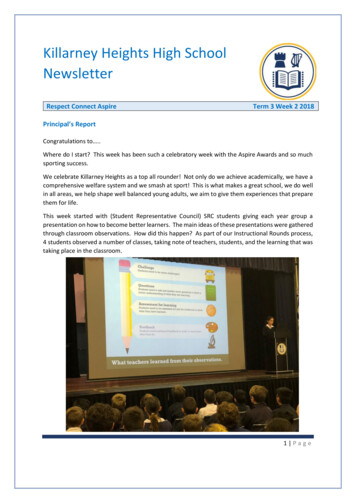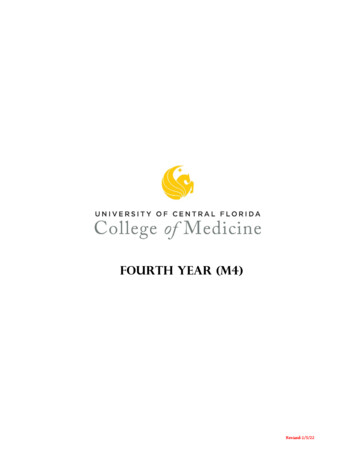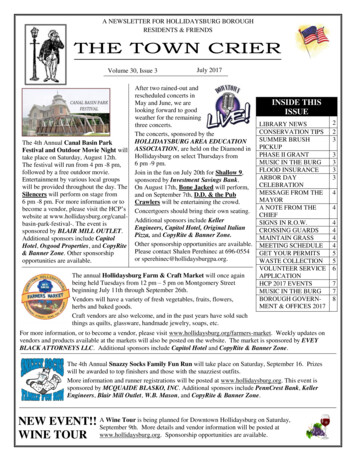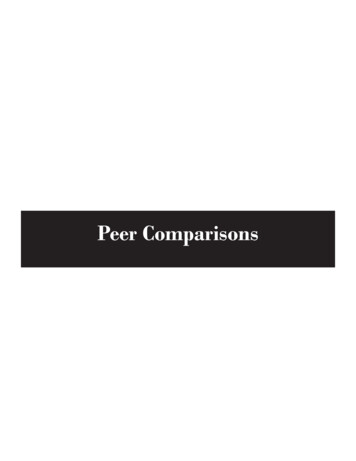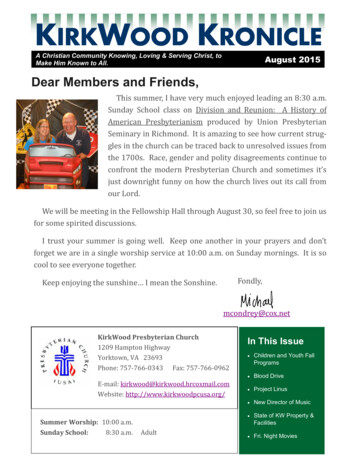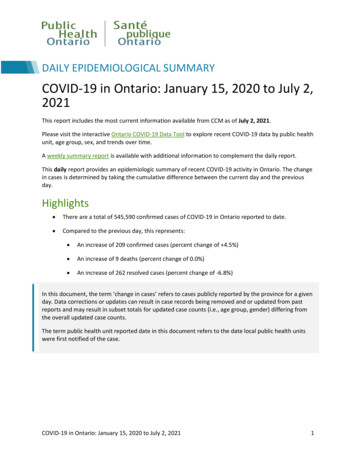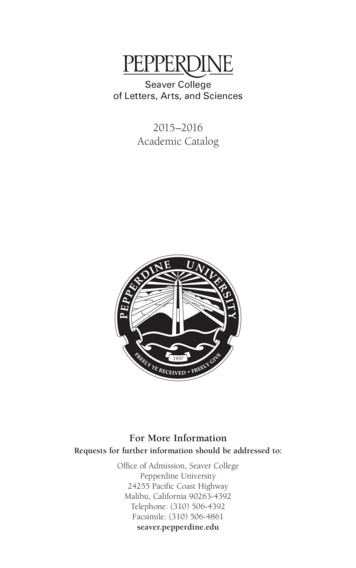
Transcription
NACUBOJULY/AUGUST2015AegnahClrihWof
FundingDynamics 16PresidentialPerspectives 19The Diploma’sStaying Power 29It’s Not UsVersus Them 33Three ChallengingTrends 36NACUBOJULY/AUGUST2015Economicsin MotionPublic misconceptionsand financial realitiescome together topropel the need tochange the economicmodels for highereducation institutions.
ECONOMICS IN MOTIONFunding DynamicsPublic misconceptions and financial realitiescome together to propel the need to change theeconomic models of higher education.By Bob Shea and Jacalyn A. AskinIs higher education, as an industry,required to deliver immediatereturn on tuition payer and taxpayerinvestment, or is the value of aneducation delivered over the entirety ofone’s lifetime or over multiple generationsof family history? That’s a question thatThe New York Times columnist Frank Bruniraises in a Feb. 11, 2015, opinion piece,“College’s Priceless Value,” in which heeloquently describes the challenges facinghigher education.Bruni adds nuanced reason to thecurrent debate raging about the valueand utility of education in an era definedby resource scarcity. He writes, “And it’sdangerous to forget that in a democracy,college isn’t just about making betterengineers but about making better citizens, ones whose eyes have been openedto the sweep of history and the spectrumof civilizations.” Thus, he asserts, highereducation has to deliver on the wide ranging societal expectations that we produceAdvisory CommitteeFollowing is the list of individuals who serve on the NACUBO Economic ModelsProject advisory committee:Beth AkersBrookings InstitutionBryan AlexanderConsultant/FuturistWalter G. BumphusAmerican Association ofCommunity CollegesNimalan (Nim) ChinniahNorthwestern UniversityKevin CorcoranLumina FoundationErin CurrierThe Pew CharitableTrustsRoger FergusonTIAA-CREFRobert D. Flanigan Jr.Spelman CollegeJ. Michael GowerRutgers, The StateUniversity of New JerseyPhilip J. HanlonDartmouth CollegePamela JacksonEmersonPaul JennyUniversity ofWashingtonAndrew KellyAmerican EnterpriseInstituteBarbara LarsonJohnson CountyCommunity CollegeDevorah LiebermanUniversity of La VerneHorace MitchellCalifornia StateUniversity, BakersfieldBUSINESS OFFICER JULY/AUGUST 2015James E. NevelsThe Hershey Co.Morgan R. OlsenArizona State UniversityEduardo J. PadrónMiami Dade CollegeScott D. PattisonNational Association ofState Budget OfficersElizabeth L. “Beth” PaulStetson UniversityGary D. RhoadesThe University ofArizonaPenny RueWake Forest UniversitySuzanne WalshBill & Melinda GatesFoundationnot only capable engineers, scientists,doctors, and social workers ready to moveinto the workforce, but also educatedcitizens ready to take on the significanteconomic, cultural, and societal issues weface as a nation.Seismic Shifts in HigherEducation Funding SourcesBruni is one of the many voices expressing the view that a college education’spurpose is to go beyond the practical toprovide a lifetime of value to studentsand our society. However, in recent years,this broad vision of education’s rolehas seemingly taken a back seat to thenotion that the primary value of a collegeeducation is to land a good job and realizethe economic benefits attached to higherlevels of education.While the public discourse and relatedperception (and skepticism) about thevalue of higher education have beenshifting, the costs of providing that education continue to rise, with the burden ofpaying the bill increasingly shifting toindividual students and families. Existingcost structures, coupled with increasinglyconstrained public resources to supporthigher education, have led many to theconclusion that the underlying economicmodels used by most colleges anduniversities may not be sustainable in thedecades that lie ahead.Persuasive Messaging,Sustainable FinancesIn reflecting on NACUBO’s strategicpriorities relative to these critical issues,the board of directors agreed that twoinitiatives were of paramount importance.First, that NACUBO speaks more clearlywww.nacubo.org
and forcefully about the broad value ofhigher education—both to students andsociety—as well as about the value ofour institutions in their respective communities. Second, that NACUBO providesresources to its members, to guide themthrough the complex and difficult task ofassessing their respective institution’s economic model and considering changes thatcould place the institution on a strongerand longer lasting financial foundation.Ways to build value and awareness. Toaddress this first challenge, the boardembarked on (1) an effort to identify themost effective messages to reinforce theoverarching value of a higher education,and of a college or university to itscommunity; and (2) a strategy for theassociation and its members to use thesemessages in their own efforts to convinceconstituents of higher education’s valueand ongoing benefits. This projectis expected to be completed laterthis summer.Strategy to increase economic stability.The second initiative—finding ways tohelp individual colleges and universitiesassess and strengthen their long-termeconomic health—gave rise to NACUBO’sEconomic Models Project.Like any large-scale planning process,analyzing and making major adjustmentsto institutional processes and strategiesrequire that important questions be askedand answered. For the Economic ModelsProject, the four questions are:o Where are we?o Where do we want to go?o How do we get there?o How do we know we’re getting there?www.nacubo.orgUsing these questions as a guide, thismultiyear effort will study the current stateof higher education economic modelsand how they have evolved to where theyare today. Throughout the various stagesof the project, NACUBO staff will beworking closely with member institutionsand various other stakeholders. Based onthe responses to the questions and otherdata, the project will develop resourcesto facilitate a data-driven analysis of aninstitution’s existing economic model andpossible changes to that model.In the final phase of the project,NACUBO will develop a toolkit for campusdiscussions about economic modelchange. Our goal is to design documentsthat boards, presidents, and theirleadership teams can use to walk theirinstitutions through the difficult structuraland cultural challenges and innovationsneeded to propel campuses toward longterm financial sustainability. Focusedon implementation, these documentswill not offer a prescriptive solution. Ourintent is to make them a valuable leadership and management resource that willhelp individual colleges and universitiesdevelop solutions that address the uniqueneeds of their institutions.In the article that follows, fouruniversity presidents, who serve on theEconomic Models Project advisory committee, provide perspective on strategiesfor approaching higher education’s challenges: self-investment in a candid lookat issues and solutions; the importanceof creating a culture that is passionatefor educational achievement; addingentrepreneurship to the ways and meansof academics; and the need for cost containment that does not sacrifice quality.Also, in a collection of essays, two members, who also are part of the committee,describe the enduring power of the collegedegree; and the trends that will continueto challenge higher education. A facultymember discusses the importance of faculty support in sustaining the institution.As is evident in the articles, taking theinitiative to re-examine long-standingeconomic models will require strongleadership as well as compelling communications to our stakeholders. However,with this inspiration and knowledge,campus communities—empoweredwith data and a shared commitment tostrengthen their institutions—can be ourbest hope of preserving these engines ofthe American economy, our society, andan interconnected world.BOB SHEA is senior fellow, financeand campus management, NACUBO.JACALYN A. ASKIN is higher educationeconomic models project ST 2015 BUSINESS OFFICER
ECONOMICS IN MOTIONPresidentialPerspectivesFour presidents share their thoughts on why the current economicmodels at higher education institutions need a major change—now.By Bob SheaWith very few exceptions, the economiccondition of higher education institutionsis under stress. For public institutions, statefunding has seen such significant declinesin the last decade that costs have shiftedto students, who now must pay much higher tuition. And manyof the small private institutions that are heavily dependent ontuition find they must offer deep discounts, just to get studentsin the door.Clearly, conditions seem to call for a dramatic makeover ofthe economic models in use in today’s higher education system.There is a great need to drive changes—both cultural andstructural—that make institutions financially viable in thedecades to come. So where do campus leaders begin, andhow do they conduct conversations with stakeholders in theirinstitutions and the higher education industry?Business Officer interviewed four college presidentsand asked each of the leaders to talk about his or her administrative and academic successes, institutional challenges,and steps being taken to be financially sustainable—all whilethey continue to provide the best academic experiences andopportunities for their students. The presidents also haveagreed to serve on the advisory board of NACUBO’s EconomicModels Project.www.nacubo.orgPhilip J. Hanlon, president of Dartmouth College, Hanover, N.H.,since 2013, is an academic and administrative leader who helda succession of administrative leadership roles at the Universityof Michigan for more than a decade, most recently as provostand executive vice president for academic affairs. Hanlon also hasbeen serving on the NACUBO Board of Directors since 2010.Devorah Lieberman is the first female president in the 123-yearhistory of the University of La Verne, La Verne, Calif. With morethan 30 years of higher education experience, she was one of13 national scholars invited to participate in the three-year Projecton the Future of Higher Education, from 2002 through 2005.Horace Mitchell became the fourth president of California StateUniversity, Bakersfield, in 2004. A psychology professor withresearch interests in the areas of identity construction, multicultural psychology, and psychological assessment, he continues toteach. Mitchell also has been serving on the NACUBO Board ofDirectors since 2012.Eduardo J. Padrón has served as president of Miami Dade College,Miami, since 1995, where his work is hailed as a model of innovation. No fewer than six American presidents have selected Padrón,an economist by training, to serve on posts of national prominence.JULY/AUGUST 2015 BUSINESS OFFICER
ECONOMICS IN MOTIONPhilip J. Hanlon onSelf-InvestmentHigher education institutions areon a financial path that’s unsustainable. Although we haven’tyet reached the breaking point, we maybe getting close. For the last four decades,sticker price increases at institutions havebeen well above any rate of inflation—2 to 3 percent—on an annual growth rate.Campus leaders need to get out infront of this issue with a sense of urgency.One of the problems that we face is: Wepresidents are a group of independentoperators with no organizing group. We are3,000 different players, each doing our ownthing, which is why I tend to think that thechange will have to come from outside thehigher education system.It might take a suitable shock fromthe outside before higher educationleaders become—by necessity—inventive. If the next act of Congress, afterthe Affordable Care Act, is the HigherEducation Affordability Act, institutionsmay face any number of requirements.Then leaders might say, “OK, we’ve gotto be creative. We’ve got to do somethingdifferent.” But, I just can’t see it comingfrom within the system, because presidents at higher education institutionshave learned to be cautious.It’s All About the RankingsMany college presidents fear making bolddecisions. Just look at the phenomenonthat’s been going on in the last 40 years.I call it “the great homogenization ofhigher education.” Everybody is trying tobe the same, to offer the same facilities,programs, activities, and services. As Iwas leaving the University of Michigan,Ann Arbor, four regional universities wereopening medical schools. Why? Because IBUSINESS OFFICER JULY/AUGUST 2015think it’s all about rankings. We’re all chasing the same goal. No one wants to stepout and say, “We’re different.”At Dartmouth, our year-round calendarmakes us a bit different and gives us aneconomic advantage. Without this kindof schedule, we would have to build moreresidence halls, expand our classrooms,and make adjustments on the facilitiesside. I believe that more colleges anduniversities can benefit financially byadopting year-round operations.When we educate students, we providethem with two qualitatively differentthings. One is knowledge—the facts of theworld and the intellectual frameworks sothat this information makes sense to us.Second, we develop their skills for successin the world: the ability to communicateeffectively, critical thinking skills, a welldeveloped creative mind, the confidenceto innovate and take risks, the ability towork effectively with others, and leadership skills.New technologies allow us to shareknowledge in new, low-cost ways. Thismeans that our key value-added willincreasingly be the ability to develop skillsto succeed in the world.Obtaining these skills requires a different kind of instruction. Students don’tdevelop the confidence to innovate andtake risks by participating in a massiveopen online course (MOOC) or sitting inthe lecture hall. They get these skills byfailing, by being coached, and by tryingagain. They learn by doing, rather thanlistening. It’s absolutely critical thatwe develop ways to measure growth inexperiential learning. But one of the bigchallenges ahead of us is to find effectivemeans to measure growth in these skills.How Are We Doing It?Part of our vision at Dartmouth is to selfinvest by prioritizing all of our activities,which frees up resources for excellenceand high-priority initiatives. Similar tomany successful organizations, we requirein the budget process that every department explicitly identify 1 1/2 percent ofits spend that it is going to stop, and thendescribe how it is going to invest thatmoney in innovation or excellence.Initially, requiring that movement offunds was scary. Who wants to cut theirbudget? People were grumpy until theyinvested in their new activities, whichmade them feel empowered. Of course,they eventually asked, “We aren’t going tohave to do this again next year, are we?”My answer: “Yes.”Structurally, universities are very stableorganizations, partly because many keyemployees have lifetime contracts. And,our students are here for multiyear gigs,so we can’t say, “I’ve decided to close thephysics department until we have morecustomers.”Because institutions have so muchstasis and stability, I believe that modestreallocations, repeated relentlessly overa period of years, are the right way toachieve reprioritization and efficiencies.If units can examine their budgets andask, “What’s my least effective spend? Canwe improve this process so that two staffmembers accomplish what it takes three todo now?”—that drives efficiency.Of course, the departments that areable to achieve this are the bigger ones,such as arts and sciences, engineering,and facilities and operations. They have tobe big enough to move things around; theclassics department with two employeeswww.nacubo.org
MARYANNE RUSSELL, DARTMOUTH COLLEGEwon’t be able to do this. We also haveplaced restrictions on what classes can beoffered; we now require classes to have atleast five students enrolled in them.The whole notion of institutionwideprioritization and reallocation can bealien to faculty members, some of whomhave not taken kindly to the approach. Wejust keep emphasizing the positives thatresult: “You now have 1 1/2 percent of yourbudget with which to do great things.” Wecontinue to make the same argument overand over—that we’re liberating dollars forimportant projects.A few faculty members have told me,“Until you got here, we raised tuition4 1/2 to 5 percent each year. Why don’t wego back to those good old days? We won’twww.nacubo.orghave to do all this cutting and prioritization.” As presidents, we need to continuechanging that old mindset: “How muchrevenue can we get in the door and howshould we spend it?”The new mindset is, “What’s theminimum we need to spend, and howdo we get the revenue to do that?” Notsurprisingly, the faculty members who bestunderstand that are the ones who havechildren enrolled in colleges.A National ObligationNot too long ago, I had a meeting withThe Wall Street Journal editorial board. Wetalked about higher education issues andwhat we are doing at Dartmouth to slowdown the growth of the sticker price andget it under 3 percent. The board asked,“Why are you doing this? You’ve got moreapplicants than you can possibly admit.They are willing to pay almost anything tocome to Dartmouth.”We’re fortunate, but I understandthat not all institutions have the sameadvantage. The economics are really badfor tuition-dependent small colleges thathave to offer a discount just to get studentsin the door.While there will always be the highlyselective colleges and universities that, atleast in the foreseeable future, are goingto be highly sought after at any pricepoint, we, as presidents, have a nationalobligation to control costs. It is the rightthing to do.JULY/AUGUST 2015 BUSINESS OFFICER
ECONOMICS IN MOTIONDevorah Lieberman onCampus CultureThe NACUBO Economic ModelsProject has the potential to bebold, nimble, and groundbreaking.It is my goal to contribute to this effortby drawing from my experience workingwith various financial models, establishing and maintaining student learningoutcomes, and preserving campus vitality,because it is time—perhaps overdue—forhigher education to be bold, nimble, andgroundbreaking.I began my career as a professor atPortland State University, Ore., where Ideveloped a deep commitment to studentsuccess, knowledge acquisition, andstudents’ commitment to communityengagement. When I shifted my primaryresponsibilities from the classroom intoadministration, Portland State was undergoing a significant transition: creatinglearning communities and implementingentirely new general education requirements that included interdisciplinaryconnections and community engagement.I was eager and honored to play a role inhelping design the thoughtful models forgeneral education, educational delivery,student learning, interdisciplinaryapproaches, and community engagement.Essentially, I was interested in helping totransform the campus culture.A Culture of Joy, PassionAt one point I was asked to participate ina national conversation that was formedto answer the question: “How can highereducation create models that reduceinstitutional cost while maintainingstudent learning?” I felt that the highereducation environment was ripe for thisBUSINESS OFFICER JULY/AUGUST 2015question, but that an element was missing.Rather, I rephrased the original questionto ask, “How can higher education createinstitutional models that reduce the costof educational delivery; enhance studentlearning; and concurrently supportfaculty, staff, and administration vitality?”If our business models only focus oncost and student learning, we may beachieving these goals at the expense ofthe vitality and joy of the faculty, staff, andadministration.During my presidency at the Universityof La Verne, I aim to address the wholeequation: enhancing student learningand containing cost and encouraging aculture that supports passion and joy.Each month, I ask two faculty members tochoose 10 other faculty members and theirrespective spouses to spend an eveningat my home. Throughout the evening, wehave casual conversations while enjoyingwine, cheese, and each other’s company.We each share the source of what gives usjoy, passion, and reasons for entering andstaying in the higher education profession.This allows us to reflect on, and talkabout, our own campus climate. Theseface-to-face conversations, in an intimateand comfortable setting, help us focus onthe positive and keep us moving forward,together, in the same direction.Additionally, I try to “walk the talk.”When I assumed the presidency, one ofthe initiatives brought to the forefrontincluded a focus on establishing employeecompensation that was competitive withthe market. To that end, we formed acompensation task force that would recommend a model to achieve this outcome.The task force has established employeesalary ranges based on national data forfour-year, private, nonprofit institutions,such as La Verne.The board of trustees and executivecabinet agreed that everyone, irrespectiveof their position on campus, shouldbe compensated at the median, plus aregional multiplier. This initiative, withthe goal of bringing all employees’ salariesto the median, may take several years tobe achieved; however, there is a feeling ofconfidence on campus that compensationconcerns are being addressed fairly and ina timely manner.A Commitment toInstitution ValuesFurther, there is intentionality inreinforcing the 124-year-old values of theUniversity of La Verne: lifelong learning,ethical reasoning, civic and communityengagement, and diversity and inclusivity. These four values are interwoventhroughout all curricular and co-curricularprograms, in all four colleges, and acrossall 11 campuses. They are also at the centerof the university’s 2020 Strategic Vision andits campus master plan; they are at thecore of everything we do.By focusing on and reinforcing the institution’s values, I firmly believe that whenyou attend the University of La Verne, youwill achieve more than you ever imaginedand you will exceed your expectations.The university enrolls 8,700 studentsacross graduate and undergraduateprograms, many of whom never believedthat college was an option. Fifty percent ofour students are first generation, and morewww.nacubo.org
than 40 percent are Latino. Hence, we arefederally designated as a Hispanic-servinginstitution. Because we’re educating thiscountry’s future leaders, we seek to developin our students skills that future employersare looking for—critical thinking, teamwork,and oral and written communication.The Critical Need for aKnowledge ModelWhen I recently delivered my state of theuniversity address, I spoke about what istaking place at the state and national levelsin regards to the College Scorecard andwhat is being measured. Reductions infederal and state financial aid to studentsattending private independent colleges arebeing considered, forcing institutions suchas the University of La Verne to think aboutalternative financial models.This institution—and others likeours—must be more nimble, relevant,and distinctive in order to remain viableand successful in the future. In highereducation, we should not be talkingabout an economic model. We should betalking about a knowledge model; a modelfocused on efficiently bringing knowledgeto the students.As leaders of a nonprofit independentinstitution of higher education, it is criticalthat we ensure financial stability. Wemust create financially stable models thatallow us to provide distinctive, relevant,values-based education for our students,while also supporting the faculty and staffin their research, scholarship, and professional development.In order to maintain costs withoutcontinuing to raise tuition, we mustbe more strategic with our educationaldelivery. We must examine our currentmodel of education delivery and its cost,as well as different revenue streams thatcan help subsidize institutional needs. Wecannot continue to believe it is as simpleas cutting budgets and raising tuition.Instead, we must adapt our delivery modeland evolve our funding sources to be morecost-effective without negatively affectingquality, student learning, and faculty/staffvitality. How we do that is a constant, ongoing discussion.www.nacubo.orgJEANINE HILL, JEANINE HILL PHOTOGRAPHYJULY/AUGUST 2015 BUSINESS OFFICER
ECONOMICS IN MOTIONHorace Mitchell onEntrepreneurial AcademicsBefore we move to the question ofthe sustainability of the higher education funding model, we shouldacknowledge the great diversity that existsamong higher education institutions, andthe perceived value of a higher educationdegree. Different sectors of higher education have different missions, fundingmodels, needs, and constituents. In looking at the value of public universities, wemust consider what institutions contributeto educational attainment; to the qualityof life for individuals, their families, andcommunities; to workforce development;and to regional economic development.All Student Debt Is Not EqualThere is always a discussion of whetherhigher education is a private good or apublic good. Many people, particularlythose who have not had much experiencein higher education, see it as a privategood and, therefore, believe that theindividual should pay. Others view it asa public good that adds benefits to theentire state, so states should bear part ofthe costs.Unfortunately, most people still believethat public universities are entirely fundedby states, which is absolutely not the case.The significant investment that Californiamade in public higher education in1960 under the Master Plan for HigherEducation has gone by the wayside. Forpublic universities, it is not so much thatthe cost of education has gone up. Rather,states have withdrawn large percentagesof their funding. We are seeing a cost shift,and students are now bearing a higherpercentage of the load.In the case of California State University(CSU), the state is funding about 50 percentBUSINESS OFFICER JULY/AUGUST 2015of the cost of instruction. By the time we addin other funding sources, such as contractsand grants for research and studentprograms, fundraising, and various auxiliaryenterprises, the state portion falls well below38 percent of total revenue. This is verydifferent from what it was in the past. Sostudents must pay more—not because theuniversities are costing more—but becauseof the cost shifts from the state to individualstudents and their families.Fortunately, student debt is not asignificant issue in the CSU System, and,in particular, at CSU Bakersfield (CSUB).According to our data, about 50 percent ofthe students in our system, whose familieshave incomes of 70,000 or less, essentiallypay nothing to attend CSU after receivingPell Grants, Cal Grants, State UniversityGrants, and other financial aid. Theyhave no debt. For others, the total debt isapproximately 18,000.Although student debt is not an overwhelming problem here, that fact gets lostin the larger national discussion whenthe front page of The New York Times,The Wall Street Journal, or The Chronicleof Higher Education proclaims that theaverage amount of total debt for studentsis 29,000. For some state universities, thatis an exceedingly high number.Revamping to Meet FutureEducation NeedsThe financial model of heavy dependenceon state appropriations and student fees isno longer sustainable. In light of that fact,the California State University, with morethan 430,000 students on 23 campuses,is exploring alternatives. CSU ChancellorTimothy White has formed a Task Forceon a Sustainable Financial Model, whichis charged with “proposing a sustainableplan for the future with respect to budgetallocations, revenue generation, enrollment management, and institutionalfinancial aid policies.”The group began its work last Octoberand is expected to have a draft reportwithin a few months. So how are we tryingto meet the financial challenges that besetour campuses in the meantime?When we developed the vision statement for CSU Bakersfield, we put a dateon it, which is unusual. Vision statementsare supposed to be aspirational. Well, ourvision statement reads, “By 2014–15, CSUBakersfield will be the leading campusin the CSU system in terms of facultyand academic excellence and diversity,quality of the student experience, andcommunity engagement.” It goes on tosay that we will advance our vision “byhiring, development, and promotionof excellent and diverse staff within anorganizational culture committed toexcellence in all areas.”o Advance the vision. In January, theCarnegie Foundation for the Advancementof Teaching classified CSU Bakersfield asan “engaged” university, after a very rigorous,evidence-based process. We see this voluntary classification as being a validationof our commitment to strengthening ourcommunity engagement, as stated inour vision.We currently are in the process ofchanging our academic calendar fromquarters to semesters, and, even moreimportantly, completing curricular transformations in 70 percent of our academicprograms. Rather than simply convertingcourses that have been on the books fortwo or three decades, faculty members arewww.nacubo.org
GREGORY COOKreconceptualizing their curricula in anticipating future student and communityneeds. In addition, our academic senatehas worked with our faculty to totallyrevise our general education requirementsto make sure that they are in alignmentwith our set of universitywide studentlearning outcomes.o Increasing efficiency. We have takensteps to increase efficiency by collaboratingwith other campuses. For example, withour campus size, we cannot afford policedispatching all night long, so we worked outan arrangement with CSU San Bernardino,a larger campus, to handle our after-hoursdispatch. In another example, we decidedto contract with California State University,Fullerton, to borrow one of its project managers to manage our new student housingproject, which has 500 beds.o Offsetting financial obstacles. Enduringfiscal hardship has forced us to beentrepreneurial. For example, we wantedto start academic prog
BUSINESS OFFIC ER JULY/AUG UST 2015 www.nacubo.org www.nacubo.org JULY/AUGUST 2015 BUSINESS OFFICER 17 . return on tuition payer and taxpayer investment, or is the value of an . Stetson University Gary D. Rhoades The University of Arizona Penny Rue Wake Forest University Suzanne Walsh



